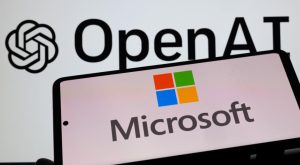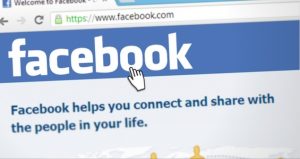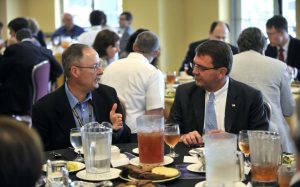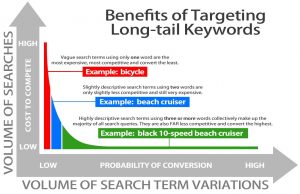For more than a year now, Teresa Herd has been putting together Intel’s Agency Inside to drive greater quality and better brand alignment.

Intel Corporation Headquarters — The Robert Noyce Building, Santa Clara, California (Photo credit: Walden Kirsch/Intel Corp.)
In September of 2014, Teresa Herd joined Intel as the brand’s vice president global creative director. A year into her role, Herd began building Intel’s in-house agency, aiming to create greater quality and better brand alignment in a more cost-efficient way.
She says the great thing about working at Intel is that the brand is 100 percent authentic.
“I get to work on things every day that are absolutely amazing,” says Herd, “I find out about technology, and I’m like, can you believe this? I don’t have to make anything up — ever.”
After a 14-year tenure with Staples, Herd came to Intel to lead the brand’s global creative vision, aligning its marketing strategies with its business objectives. She is responsible for all of Intel’s creative content — from advertising and online content to product design and client communications — for all of the brand’s business units and geographies.
When asked about what’s to come, she says her future depends on what Intel is getting into next, and the great people she gets to hire.
Herd was generous enough to share how Intel’s in-house agency works within the brand, as well as the challenges of managing the in-house team — from finding the right talent to keeping a consistent voice across Intel’s business lines and markets.

Teresa Herd
VP Global Creative Director @ Intel
Takeaways:
1. First rule: If you do not have actual global advertising experience, don’t have any rules to start.
2. Listen to the local markets, and never compromise on quality.
3. Find an agency that actually has a global footprint and be righteous about the process for brand oversight.
Amy Gesenhues: As head of Intel’s creative, what do you oversee beyond the in-house agency?
Teresa Herd: My exact title is VP global creative director. That means … that I oversee the creative development for all brand-elements of Intel.
So anything that is customer-facing, and internal, I oversee the creative strategy and development of it.
AG: How much of Intel’s creative strategy and development is handled in-house?
TH: The internal agency — we call it Agency Inside — does not necessarily execute all of that work. My role is global — I oversee work in all of the “Geos,” and I have a really integrated model.
When I came to Intel, there was not an Agency Inside. I’ve been here going on two and a half years, and we probably did, I would say, 96 percent of our work with external agencies — we did a little bit in-house, we had a small production team — but, other than that, it was executed by external agencies.
Having run an internal agency before at Staples, I saw — as did the CMO, which is why he brought me here — the opportunity to execute a lot of that work in-house that would give us great quality, better brand alignment, and at a model that was more cost efficient than using external agencies.
Over the course of the past year and a half, after I developed the structure of the agency, I’ve been bringing different parts of the work in-house. We started with social and digital, as well as a lot of the actual brand work that we do.
I’d say today, probably 65 to 70 percent of the work is done in-house, and the rest we continue to use external external agencies to divide it up.
AG: What work are you still using external agencies to complete?
TH: It’s largely broadcast. We still use outside agencies for most of our broadcast for B2B and for retail — those are the things where I still believe we need external expertise that I don’t think we have yet internally.
I’m trying to scale and bring things in-house where I know I can be successful, and not grow too quickly — so I don’t drop balls or I don’t have the competencies that I need to do it well.
I don’t know if we’ll bring in those parts of advertising at some point. We grew pretty quickly. We’re up to, I think, 80 people — probably close to 100 by the end of the year. I’m really working on shoring up our processes and making sure that the quality of the work is really great.
It may happen that we’ll bring in other parts of the work, but today that’s where we are.
AG: What is Agency Inside’s process for working with Intel product teams?
TH: We function very much like an external agency would, with our only client being Intel.
I have many of the same roles you would find in a traditional agency, or an integrated marketing agency. We work with marketing partners who write the business strategies and come to us with requests for either assets or whole campaigns.
We consider them and treat them like our clients, with the only difference being [that] we really do have a vested interest. I think when you’re an external agency, it’s much easier just to take the work in and say,”Oh, they asked for XYZ-thing, we’re going to give them that,” because they want the work. Especially when you’re working with a company like Intel — agencies are very eager to work with us, and sometimes at the detriment of the work.
My goal is to always create the best work, and always answer the client’s needs, but also to push them sometimes. To say, “I know that you said you wanted this — this is what we’ve done for the past however-many years — but can we look at it differently? I think there might be a different opportunity that would give us greater returns.”
Or, sometimes I say, “I don’t think it’s worth doing this project — I don’t think that spending money here is the right thing to do.” An external agencies would never do that. They would say, “Here, we’ll do that — and how about we do five of them.”
I do wear an Intel hat, and I really do keep the business top of mind — not just to deliver what they’ve asked for, but to deliver something that I believe is going to work as hard as possible for the media that we have, and for what I know about the business and insights that I have — that an external agency simply would never have because they don’t sit here every day, and they’re not part of every conversation.
AG: Do you believe Intel product teams have greater trust in the work from an in-house agency versus an external agency?
TH: I don’t know if it’s greater trust. I think that sometimes I’m like, “Oh my god, why can’t they just do this thing?” Because, again, if I was an actual agency and you want me to do an animated 10-video series — I would go make that for you, because you’re a client and that’s what you’ve asked for.
I think, with us sometimes, it’s like, “Why are they pushing back so hard on a strategy?” or “Why are they pushing us to think about this in a different way — we just want what we want.”
It definitely has put some some people a little bit out of their comfort zone, and made us work harder to be more thoughtful about what Intel’s asking us to do, or what Intel is putting out in the market. So I don’t think it’s a matter of trust — because I think if you ask any of my clients they would say that the work is really good.
The work we’ve been doing since I got here a couple of years ago is outperforming the work that was done previously by a long shot, but there is definitely some inherent “Why can’t we just get that thing that that we want?” And I recognize that, and try to show the value of doing something differently.
I think we typically get very good outcomes when we have those conversations.
AG: How do you keep brand messaging and creative consistent across all of Intel’s business units and geographic locations?
TH: This has been one of my greatest challenges at Intel, but also an area where I’ve had I think a lot of success.
Prior to coming to Intel — and this happens with so many brands — the internal clients get tired of something very quickly. They’re like, “We did that — let’s try something else.” I think it leads to a lot of brand confusion.
When you ask people, “What brands do you like?,” they always tell you brands that are super-consistent, right? They’re always like Apple or Google or Nike — and it’s like, “Well what do you like about them?” And they say, “It feels clean or easy to navigate.” That’s because they don’t change it — you learn how to identify the brand.
We’ve done that — I think. I wish I could say every time someone sees an Intel piece of communication, they know it’s from Intel. I don’t know if we’re there yet, but we’re certainly trying to have best practices when it comes to how we look and how we sound.
I try not to have rules because I find when I do, they are usually broken very quickly — but when you truly work for a global brand, it is so important to listen to what the Geo has to say, and really understand the nuances of the local market.
A lot of people march in and say, “This is what it looks like, this is what it sounds like.” I think when companies do that, they don’t speak to the local market, and they don’t feel authentic.
When I first came in, we had established a campaign with McGarryBowen, and I went out to all the Geos and I said, “All right, you know this is the direction we want to take. What do you think?” And they all said it wouldn’t work — definitely wasn’t got to work in their Geo because of this, that and the other.
I said, “Okay, why don’t you guys take this idea, go back to your local agencies, and come back to me with something that you think will work?” And nine out of 10 of those Geos and regions came back with something that was so similar to what we had originally pitched, but it had a local nuance. I was like, “Oh, I can see the difference.”
AG: What have been your biggest obstacles in setting up Agency Inside?
TH: Initially, it was getting my first hire. We’re in Silicon Valley, we’re not in the city. It’s a long drive from San Francisco, and I don’t think I realized — because I’m not from the West Coast — how difficult it was going to be to get good talent.
I hired Yogi Graham, and he is head of the Intel’s global production lab. He was my first hire, and he’s amazing. I’ve held this to to be true in every job I’ve had — always hire people who are better than you. He’s so smart at what he does, and he’s really good in a very specific part of the group that I would never have that depth, that expertise.
I hired him, then started doing these interesting “Maker Stories” — a whole series of films about makers out there changing the world, and they’re beautiful films.
As soon as I started doing those, all of a sudden, other talent was attracted and other talent was taking notice, and people felt differently about the brand.
I recently opened an office in San Francisco about six weeks ago. It was something I had wanted to do. Once I got the green light to do that, it was something I could tell people, “Look, we’re going to open this office in San Francisco — so get to hiring people.” Then it became that much easier [than] trying to get people to drive down out of the city to Santa Clara, which wasn’t going to happen.
Thankfully, I had the support of management that recognized I can save a ton of money by saving on retainer and agency fees, but I need to be able to go to where the talent is. And once I was able to get a couple of good people, now I have people reaching out to me all the time to see if there are any jobs here.
So, I think that was probably the most difficult thing. And then, always being new to an organization is proving oneself, and doing something right, and gaining credibility.
For me, thankfully, it was the first Parson’s campaign we did. It was my first big campaign — I was only at Intel for like a month. I worked with McGarryBowen and picked Jim as as our talent. It was supposed to be for one quarter, and we were going to move on to something else. And then, it did so well that we are obviously now into a multi-year contract with him.
Making a couple of good smart decisions that panned out — and delivered results — was huge for me. Prior to that, it was, “Who is she?” and “She came in with the CMO,” and “What does she know?”
I was trying to change so many things, and I was like, “Okay, I need to prove that I know what I’m doing a little bit here before someone is going to listen to me and believe me.
AG: How did Jim Parson come to represent Intel?
TH: So that was my first campaign. The agency had pitched another celebrity to be the lead, and I was like, “I don’t think he’s quite right — I don’t think he’s the right guy. He’s not right for our demographic.”
I was literally walking out of the agency, and there was a newsstand with the Adweek Magazine with Jim Parsons on the front that said, “America’s most lovable nerd.” I picked it up, and I handed it to the creative director. I said, “Get him — he’s our guy. He’s the one.”
And that was the beginning of a great campaign for us.
AG: What do you think are the biggest differences between working with an in-house agency and using external agencies?
TH: I think a couple of things. My team wouldn’t agree with this, but I think we get stuff done quicker.
I have instant and constant access to the business. When you work in an external agency, you don’t. You’re probably working with a lower-level marketing manager who may or may not have decision-making power, who may or may not have the time to talk to you — probably doesn’t have time to talk to a creative.
I can literally walk over to the head of marketing for any product and get clarification, or say, “Hey, can we look at this differently? I know you asked for this, but can we show you something else?”
So the speed at which decisions can be made goes much quicker because of the access that we have. I also have oversight to pretty much everything the company is doing, so I can either direct people to someone or leverage something that’s being done somewhere else, because I actually sit at the table with all of the marketing folks. We all report to the CMO, and I am at the top of those conversations when the planning cycles are happening. Most agencies would die to have a seat at the table.
We’re in so many places, and we have access to not just the technology, but the people who own and create that technology. If there’s something interesting happening, or if I’m looking for a particular story for an ad, I can go to that person and ask them if they’re interested, or ask them for help. When you’re at an agency, sometimes the company is so big, you don’t know how to navigate it.
It is really nice to have constant access to the business, our clients and the technology — I think that doesn’t exist when you’re outside.
AG: Earlier this year, I interviewed The Grammys CMO, Evan Greene, about his campaign with Intel and the Lady Gaga performance honoring David Bowie. I’m curious — how involved was your team with that spot?
TH: I drove the whole performance and creative for the entire Gaga project.
I look at a project like Gaga — or we had a launch campaign recently — I’ll look at it and say, “I want McGarryBowen to do the spot, but I want us to run social, and I want us to do incremental content around it” — that I know we’re going to do maybe a better job, and it’s going to be less money, and I can make our dollars go much further.
I’m going to use McGarryBowen for the thing that they’re great at — we were shoulder-to-shoulder, side-by-side on the campaign launch for Amazing Experiences. I really integrated the team — everyone worked really well together.
On any given shoot — Jim Parsons or whatever — I’ll have my McGarryBowen team, and I’ll have my Agency Inside team, all responsible for delivering one integrated campaign, and everyone knows that. It’s not territorial — everybody helps each other.
AG: How do you hope Agency Inside evolves in the coming years?
TH: I should probably have a big-picture view. I honestly don’t know.
The way I look at it is — can we do it better, and can I do it for less, and will the work perform? That’s my criteria. Honestly, if you’d asked me two years ago, when I came here, if I would be doing the Grammys, or doing launch campaigns, I probably would have said no. So, I don’t know.
Part of it depends on the talent I attract. Part of it depends on the return on investment. Does it make sense for us to do it internally? Or is it going to cost me just as much as an external agency?
I think that there’s so much evolving with VR and those sorts of things. I can only imagine what Intel’s role is going to be in some of those technologies. I think it’s going to lead to us doing some really interesting and amazing work in the future.
I can’t say that I have a definitive plan. I haven’t had one yet, and it seems to be working. I’m a consummate opportunist, and always, always looking at doing the best possible work — and having fun. The team is great — we’ve attracted amazing talent. We are lucky to come to work every day, and being jazzed about what we get to work on.
Marketing Land – Internet Marketing News, Strategies & Tips
(61)









